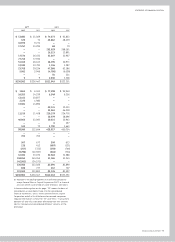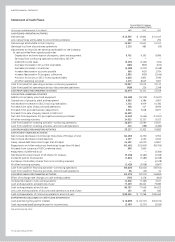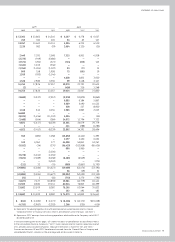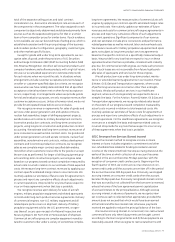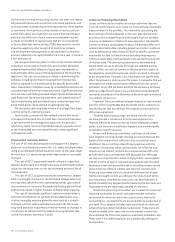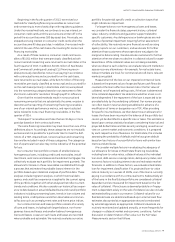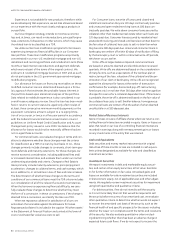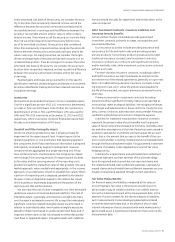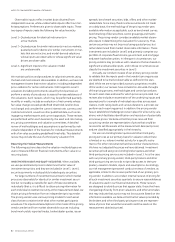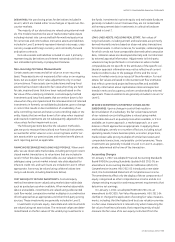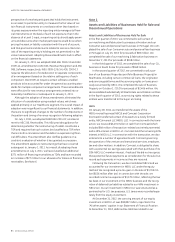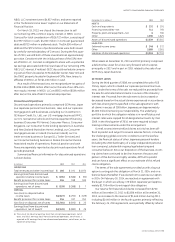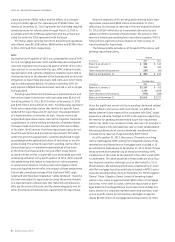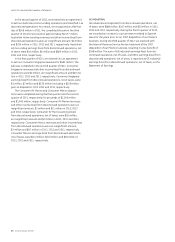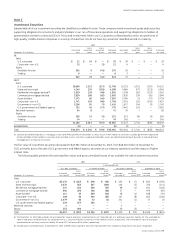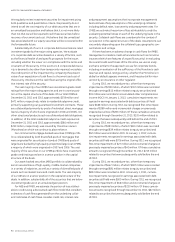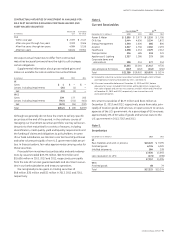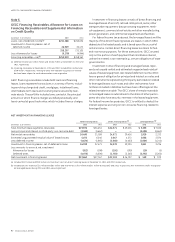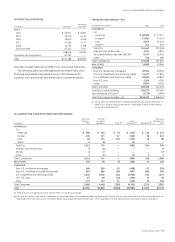GE 2013 Annual Report Download - page 85
Download and view the complete annual report
Please find page 85 of the 2013 GE annual report below. You can navigate through the pages in the report by either clicking on the pages listed below, or by using the keyword search tool below to find specific information within the annual report. GE 2013 ANNUAL REPORT 83
DERIVATIVES. We use closing prices for derivatives included in
Level 1, which are traded either on exchanges or liquid over-the-
counter markets.
The majority of our derivatives are valued using internal mod-
els. The models maximize the use of market observable inputs
including interest rate curves and both forward and spot prices
for currencies and commodities. Derivative assets and liabilities
included in Level 2 primarily represent interest rate swaps, cross-
currency swaps and foreign currency and commodity forward
and option contracts.
Derivative assets and liabilities included in Level 3 primarily
represent equity derivatives and interest rate products that con-
tain embedded optionality or prepayment features.
Non-recurring Fair Value Measurements
Certain assets are measured at fair value on a non-recurring
basis. These assets are not measured at fair value on an ongoing
basis, but are subject to fair value adjustments only in certain
circumstances. These assets can include loans and long-lived
assets that have been reduced to fair value when they are held
for sale, impaired loans that have been reduced based on the
fair value of the underlying collateral, cost and equity method
investments and long-lived assets that are written down to fair
value when they are impaired and the remeasurement of retained
investments in formerly consolidated subsidiaries upon a change
in control that results in deconsolidation of a subsidiary, if we
sell a controlling interest and retain a noncontrolling stake in the
entity. Assets that are written down to fair value when impaired
and retained investments are not subsequently adjusted to fair
value unless further impairment occurs.
The following sections describe the valuation methodolo-
gies we use to measure fi nancial and non-fi nancial instruments
accounted for at fair value on a non-recurring basis and for cer-
tain assets within our pension plans and retiree benefi t plans at
each reporting period, as applicable.
FINANCING RECEIVABLES AND LOANS HELD FOR SALE. When avail-
able, we use observable market data, including pricing on recent
closed market transactions, to value loans that are included in
Level 2. When this data is unobservable, we use valuation meth-
odologies using current market interest rate data adjusted for
inherent credit risk, and such loans are included in Level 3. When
appropriate, loans may be valued using collateral values (see
Long-Lived Assets, including Real Estate below).
COST AND EQUITY METHOD INVESTMENTS. Cost and equity
method investments are valued using market observable data
such as quoted prices when available. When market observable
data is unavailable, investments are valued using a discounted
cash fl ow model, comparative market multiples or a combination
of both approaches as appropriate and other third-party pricing
sources. These investments are generally included in Level 3.
Investments in private equity, real estate and collective funds
are valued using net asset values. The net asset values are deter-
mined based on the fair values of the underlying investments in
the funds. Investments in private equity and real estate funds are
generally included in Level 3 because they are not redeemable
at the measurement date. Investments in collective funds are
included in Level 2.
LONG-LIVED ASSETS, INCLUDING REAL ESTATE. Fair values of
long-lived assets, including aircraft and real estate, are primarily
derived internally and are based on observed sales transactions
for similar assets. In other instances, for example, collateral types
for which we do not have comparable observed sales transaction
data, collateral values are developed internally and corroborated
by external appraisal information. Adjustments to third-party
valuations may be performed in circumstances where market
comparables are not specifi c to the attributes of the specifi c col-
lateral or appraisal information may not be refl ective of current
market conditions due to the passage of time and the occur-
rence of market events since receipt of the information. For real
estate, fair values are based on discounted cash fl ow estimates
that refl ect current and projected lease profi les and available
industry information about capitalization rates and expected
trends in rents and occupancy and are corroborated by external
appraisals. These investments are generally included in Level 2 or
Level 3.
RETAINED INVESTMENTS IN FORMERLY CONSOLIDATED
SUBSIDIARIES. Upon a change in control that results in
deconsolidation of a subsidiary, the fair value measurement
of our retained noncontrolling stake is valued using market
observable data such as quoted prices when available, or if not
available, an income approach, a market approach, or a com-
bination of both approaches as appropriate. In applying these
methodologies, we rely on a number of factors, including actual
operating results, future business plans, economic projections,
market observable pricing multiples of similar businesses and
comparable transactions, and possible control premiums. These
investments are generally included in Level 1 or Level 3, as appro-
priate, determined at the time of the transaction.
Accounting Changes
On January 1, 2012, we adopted Financial Accounting Standards
Board (FASB) Accounting Standards Update (ASU) 2011-05, an
amendment to Accounting Standards Codifi cation (ASC) 220,
Comprehensive Income. ASU 2011-05 introduced a new state-
ment, the Consolidated Statement of Comprehensive Income.
The amendments affect only the display of those components of
equity categorized as other comprehensive income and do not
change existing recognition and measurement requirements that
determine net earnings.
On January 1, 2012, we adopted FASB ASU 2011-04, an
amendment to ASC 820, Fair Value Measurements. ASU 2011-04
clarifi es or changes the application of existing fair value measure-
ments, including: that the highest and best use valuation premise
in a fair value measurement is relevant only when measuring the
fair value of nonfi nancial assets; that a reporting entity should
measure the fair value of its own equity instrument from the


